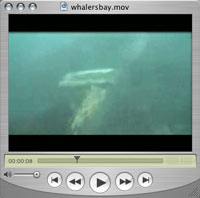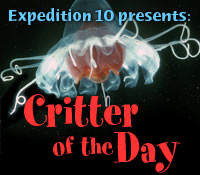|
  View Quicktime video » View Windows Media Player »  Today's Weather Partly Sunny Lat: 62 27.34 (S) Long: 63 52.8 (W) Wind: 30 KT a.m., 15KT p.m. Sea State: 4 Swell Height: 3-6 Baro Pressure: 960.5 Air Temp: 3.3°C Sea Surface Temp: 2.8°C Vis:6 NM 
  Read the new Hot Topic: Deception Island: Fire and Ice, History and Humans March 8, 2006 by Kate Madin Brennan Phillips is a graduate student at the University of Connecticut, working with biological oceanographer Pat Kremer. He is along on Expedition 10—his second cruise in Antarctica—to do his research, and he is also on the dive team. Here, he explains what he is doing. When I’m asked what I’m studying in Antarctica, I usually start with a brief description of Salpa thompsoni: “It’s a species of salp, which is a type of gelatinous zooplankton that is found in the Southern Ocean.” Normally that’s not enough to satisfy curious minds. If I’m asked for more detail, the conversation can get a little awkward: “Well, I’m studying salp poop.” Yup, that’s me. I’m the salp poop guy. Why in the world would anyone be interested in such a thing? Here’s how I explain why salp poop (technical term: fecal pellets) is important. As you can learn in the hot topics section on salps, Salpa thompsoni eat constantly and are able to reproduce rapidly and “bloom,” and their populations can extend over a large area of the ocean. This is ecologically important for two reasons: 1) So many eating animals can consume a lot of phytoplankton and 2) all of those animals have to poop (defecate), and all of that material sinks in the ocean. We human beings also need to think about where all of our sewage goes and what effect it can have on the environment. Most other kinds of zooplankton aren’t nearly as big as salps, and their fecal pellets are much smaller. This makes them sink much more slowly, and they might never reach the bottom of the ocean, because animals feed on the pellets, and bacteria degrade them on the way down. But salp fecal pellets are quite large (as big as ice cream sprinkles and sometimes bigger) and they sink rapidly, reaching the deep ocean (water greater than 1,000 meters, or 3,000 feet deep) in a matter of days. When our divers collect live salps, I take some of them and put them into large containers on board the ship. For the next eight hours or so, I inspect each tank regularly, looking for fecal pellets on the bottom. I remove them from the tank using a plastic tube and save them for later analysis. I look at some of the fecal pellets under a microscope, to see what the salps are eating, and I prepare some for chemical analysis. I also measure how large the pellets are and how fast they sink in relation to the size of the salp that produced them. Scientists know that the deep ocean is teeming with life, ranging from deep-sea fish to worms burrowing in the mud to microbial communities. Since no sunlight reaches the deep sea, no plants grow, and nearly all the animals that live there have to rely on another source of food. Nearly always, the food comes from above—the “raining down” of fecal matter and dead animals from the zooplankton thriving in the overlying waters. In Antarctica, Salpa thomsoni may play a major role in this process of transferring organic matter to the bottom. And that’s why I’m studying salp poop!
|
|||||||||||||||||||||||||||||||||||||||||||||||||||||||||||||||||||||||||||||||||||||||||||||
Mailing List | Feedback | Glossary | For Teachers | About Us | Contact
© 2010 Dive and Discover™. Dive and Discover™ is a registered trademark of Woods
Hole Oceanographic Institution
